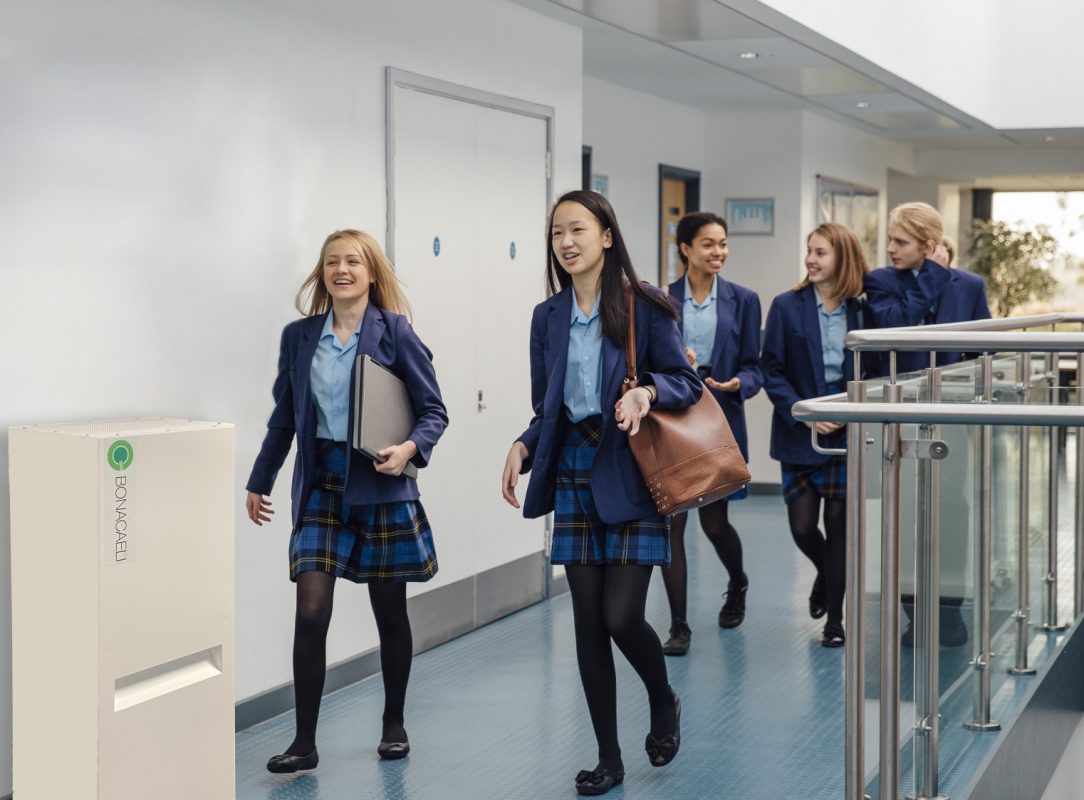Minoo Patel, Head of Technology at BonaCaeli, points to a technological solution that can help schools, colleges and universities minimise the impact of Covid and focus on delivering first class education.
The pandemic has caused unprecedented disruption to the education system over the last two years. We’ve seen school closures, grades being allocated by algorithms, university students being encouraged to defer their studies and more. Even now, despite the vaccine roll out, infection rates in schools, colleges and universities are making it challenging for teachers and lecturers to deliver curriculums as normal. As we head into 2022, what is the most effective way to tackle the infection rate, protect teachers and students and get education back on track?
There’s no question that the measures taken so far – including social distancing, mask wearing, hand washing and self-isolating when necessary – have slowed down the spread of infection and eased the pressure on the NHS. The vaccine program has been a huge success too. But, with potentially more infectious Covid variants appearing, it’s clear that we need an additional layer of protection. As well as boosting immunity and slowing down the rate of infection, we need to tackle the problem at source.
The Covid-19 virus and all its variants are primarily transmitted through air-borne mists of exhaled particles, which can remain in the air for up to three hours. It’s no surprise, then, that classrooms, where large numbers of students sit for an hour or more at a time, are hot spot areas for viruses. Improving ventilation is one way to mitigate the risk. But what we ideally need to do is not just improve ventilation but actively destroy the virus’s infectivity and remove virus-carrying droplets from the air. And the good news is, this is entirely possible with existing technology.
A new approach
Air purifiers can directly remove infected particles from a classroom by drawing in air and cleaning it using a range of technologies, including high powered ultraviolet light, filtration systems and more. Better still, air purifiers don’t care what the latest variant is – they will be equally effective against all of them; including the common cold, flu and others. By installing these devices, schools, colleges and universities can pro-actively tackle the spread of Covid, help to prevent the need for further lockdowns and minimise the disruption to learning.
The education sector is in fact already getting behind this technology. According to The Guardian, seven unions – representing teachers, school leaders, administrative and support staff, wrote to the education secretary in 2021 asking for air purification units to be installed in schools ahead of the Autumn term to filter out the virus. Not all air purifiers are the same, however. Some rely solely on ultra-fine HEPA filters to remove particles from the air, while others combine the filtration approach with other technology to actively destroy the particles.
Which air purifier should you choose?
There are several considerations in choosing an air purifier. A device that relies on filtration alone may well reduce viral transmission but is likely to have some drawbacks. For example, it may have to work harder than other devices to draw air through a series of ultrafine filters, and therefore use up more electricity while running. It may also be noisier as it will require a more powerful fan – potentially disrupting classes. Furthermore, if an air purifier relies on ultrafine filters, these may become clogged and could even harbor active viruses – requiring more frequent maintenance checks and presenting a potential health risk.
It’s therefore better to use a device that also uses other forms of technology to destroy active viruses. This will give an extra level of protection, and, by reducing the reliance on ultrafine filters, should be more efficient. The most common method used is to bathe the air in UV-C light. If choosing this type of purifier, you should ensure that the UV light is powerful enough (at least 50 Watts) to destroy pathogens. The BonaCaeli AirVSAFE 2000 goes even further and uses a Triple Air Treatment (TAT) system combining filters, UV-C light, and medical grade bio-wash. For maximum peace of mind, you should choose the most advanced option available – preferably one that is backed by the latest science and independent testing as the BonaCaeli AirVSAFE 2000 is.
Additional benefits of air purifiers
As every teacher and parent knows, schools, colleges and universities are not only breeding grounds for Covid, but for all kinds of airborne viruses. We are all familiar with the colds that regularly appear at the start of each new term. Air purifiers can reduce transmission of these unwanted viruses and have also been shown to help mitigate the effects of other health issues including asthma and hay fever. By actively improving the quality of air, education facilities can improve the well-being of staff and students and reduce the hours lost to colds and flu. In doing so, they will also improve productivity, give peace of mind to parents, and gain a reputation for looking after pupils and students that will help them stand out from other educational establishments.
We should, of course, adhere to guidelines and minimise social contact between staff, students, parents, and each other. But as social distancing is naturally difficult to maintain in classrooms, we need to take a pro-active approach to reducing viral transmission. As Covid-19 and variants are primarily transmitted by air, installing air purifiers in classrooms, canteens, common rooms and lecture halls is the most effective way to do this. So let’s do what we can to actively ensure that students and lecturers can breathe safely, and limit the cycle of infection.

